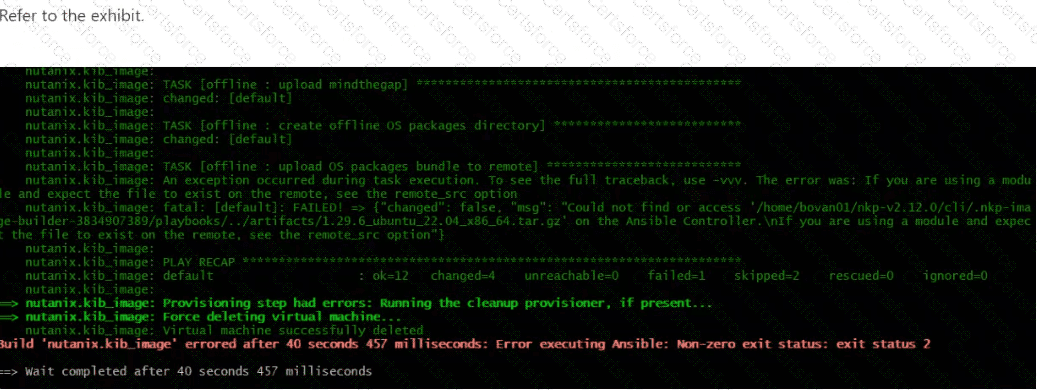
A Platform Engineer is preparing to deploy an NKP cluster in an air-gapped environment. The NKP cluster will be deployed on Nutanix infrastructure using the CAPI Nutanix provisioner (CAPX). The engineer has decided to create the bootstrap cluster first, then NIB-prep an Ubuntu 22.04 OS image that the Linux engineering team has provided in Prism Central. After that, the engineer will deploy the NKP cluster. However, during the first step of creating a bootstrap cluster, the engineer received the error shown in the exhibit. What could be the reason?
A Platform Engineer needs to create an NKP cluster on vSphere infrastructure, using the vSphere provisioning method. The cluster needs to have 3 worker node pools:
First node pool should consist of 6 worker nodes
Second node pool should consist of 3 worker nodes
Third node pool should consist of 3 worker nodesAdditionally, the worker nodes in the first node pool should be set to 10 CPUs, the second node pool workers should be set to 8 CPUs, and the third node pool workers should be set to 6 CPUs. What is the proper way to create the NKP cluster using the NKP CLI?
A Cloud Engineer is deploying an NKP Cluster in AWS. The environment is for testing purposes only, so the AWS team has requested it be deployed to use a minimal set of system resources to reduce cloud subscription fees. Which two parameters should be specified when initializing a Kommander installation, using the nkp install kommander command set? (Choose two.)
A dev team needed to optimize their logging system to be more robust, because the CPU and memory limits were insufficient, which caused delays in log collection and processing during times of high demand.
After a deep performance analysis, they decided to increase the CPU limits from 1 to 4 and the memory from 1000Mi to 4Gi.
Which ConfigMap should the development team run with custom resource requests and limit values for fluentd?
A Platform Engineer is deploying an NKP workload cluster using the nkp create cluster vsphere command. The cluster will be utilized by the company’s code-green team and the engineer has already created a code-green NKP workspace on the NKP management cluster.
After issuing the deploy command, the engineer monitored the build using the nkp describe cluster command and confirmed it completed successfully. However, a few hours later, after logging into the NKP UI, the engineer checked the code-green NKP workspace and saw that the NKP workload cluster was not there.
What is the likely reason the NKP workload cluster is not in the code-green NKP workspace?
A Platform Engineer needs to do an air-gapped installation of NKP. This environment needs to run without Internet access and be fully operational, including updates. Docker has been installed, and the NKP bundle exists on a bastion host. What is the first command that the engineer must run to begin the process?
Which NKP tier is required for the FIPS Compliant Build feature?
After a finished project, three Kubernetes clusters within a workspace were deleted, so the workspace is empty. Now a Platform Engineer needs to delete the workspace. How should the engineer delete the workspace in NKP?

A Platform Engineer is preparing to deploy a new NKP cluster on Nutanix infrastructure into an air-gapped environment. As part of the preparation process, the engineer is supplying a Ubuntu 22.04 instance to be used for NKP cluster nodes that conforms to the corporate OS image hardening standards. However, during the NIB preparation process, the error shown in the exhibit is received.
What is the likely reason the NIB preparation attempt has failed?
A company recently deployed NKP. A Platform Engineer was asked to attach the existing Amazon EKS. A workspace and project were created accordingly, and resource requirements were met. What does the engineer need to do first to prepare the EKS clusters?